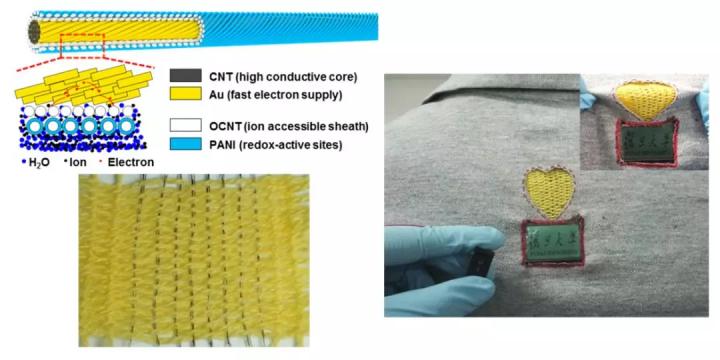
Credit: ©Science China Press
Fiber electrodes, as the key part of fiber-shaped supercapacitors for wearable electronics, are widely explored on the basis of carbon nanomaterials such as carbon nanotubes (CNTs) and graphene fibers due to their high mechanical strength, electrical conductivity and specific surface area. The incorporation of carbon nanomaterials with other pseudocapacitive materials is a common strategy to improve the electrochemical properties of resulting fiber-shaped supercapacitors. However, the pseudocapacitance is far from fully developed especially at high rate owing to the insufficient electron supply and ion accessibility during electrochemical reactions. Hence developing new fiber electrodes is very important to realize efficient electron supply and ion accessibility simultaneously in one single fiber.
Recently, Prof. Huisheng Peng’s group from Fudan University, China designed a novel family of amphiphilic core-sheath structured CNT composited fiber, i.e., CNT-gold@hydrophilic CNT-polyaniline (CNT-Au@OCNT-PANI) to meet the above requirements in Science China Materials (DOI: 10.1007/s40843-018-9408-3).
Prof. Peng stated: “The amphiphilic core-sheath structured CNT composited fiber can achieve more ion accessibility across the sheath originating from the enhanced interactions between OCNTs and PANI, and faster electron transport across the core attributing to the sufficient deposition of Au nanoparticles on the CNTs. This electrode design can improve both the electrical conductivity and electrochemical activity of one single fiber electrode.”
They systematically studied the morphologies and electrochemical properties of electrodeposited PANI on the hydrophilic OCNT and hydrophobic CNT sheath. More oxygen-containing functional groups and defect sites on hydrophilic OCNT sheath are beneficial to the infiltration and electrodeposition of aniline in the aqueous electrolyte, improving the interactions between OCNTs and PANI than those between CNTs and PANI. As a result, PANI molecules are less aggregated with more accessibility to the ions in the electrolyte during charging and discharging processes, realizing a greater pseudocapacitance utilization. As to the Au-deposited CNT core, the homogeneous distribution of Au nanoparticles facilitates the electron transport among CNTs which finally reduces the internal resistance. Impressively, the CNT-Au@OCNT-PANI demonstrates both high specific capacitance and rate capability, i.e., 256 F cm?3 at a high current density of 50 A cm?3 with a 79% retention of that at 0.5 A cm?3 (324 F cm?3). A remarkable energy density and power density of 7.2 mWh cm?3 and 10 W cm?3 are achieved in the resulting fiber-shaped supercapacitors, respectively.
“Our new concept, increasing the electron supply and ion accessibility simultaneously, can guide the future electrode design aiming at high performances,” says Prof. Peng. “And the strategy of structure design and material utilization can be generalized to other energy storage systems including but not limited to lithium-ion and metal-air batteries. We believe this finding will be of interest to readers in energy science, materials chemistry and catalysis.”
###
This work was supported by the Ministry of Science and Technology, the National Natural Science Foundation of China, Shanghai Science and Technology Committee, and Yanchang Petroleum Group.
See the article: Xuemei Fu, Zhuoer Li, Limin Xu, Meng Liao, Hao Sun, Songlin Xie, Xuemei Sun, Bingjie Wang and Huisheng Peng, “Amphiphilic core-sheath structured composite fiber for comprehensively performed supercapacitor”, Science China Materials. doi: 10.1007/s40843-018-9408-3
http://engine.
Media Contact
YAN Bei
[email protected]
Related Journal Article
http://dx.




